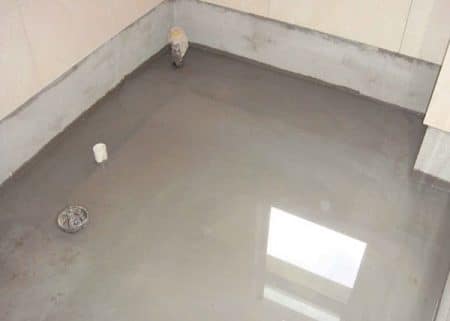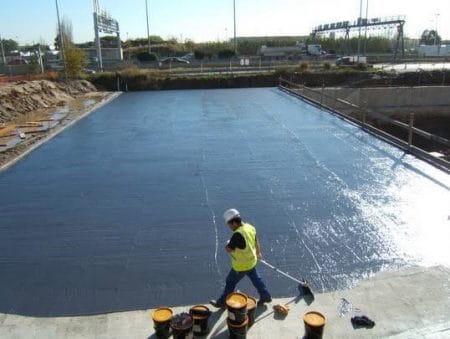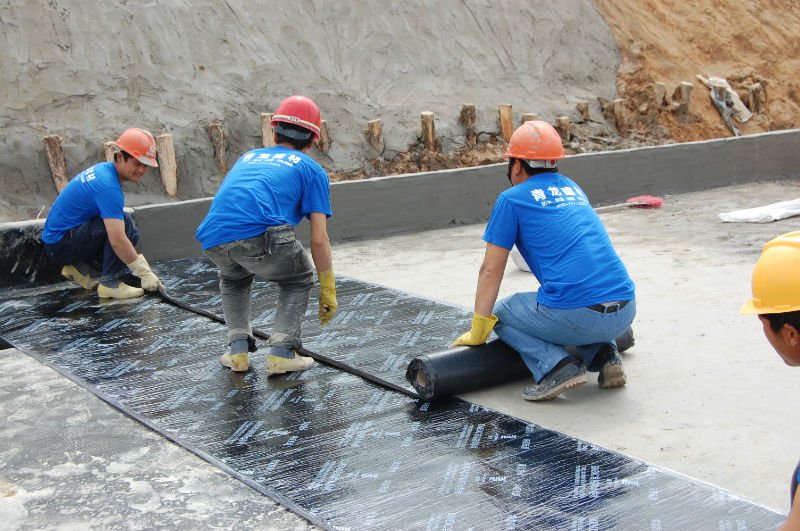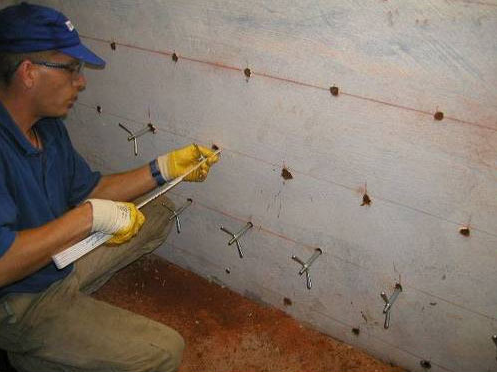Waterproofing is the application of impermeable layers on the surfaces of foundations, walls, roofs, and other parts of the building which may be concrete, leather, fabric that provide a surface impermeable barrier is to prevent water penetrations.
Such objects or structures may be used in wet environments or underwater to a specified depth.
Here we will learn about waterproofing, types of waterproofing advantages & disadvantages of waterproofing.
Introduction to waterproofing:
In short, waterproofing means protection to prevent water entering in internal and external building structures such as toilets, swimming pools, water tanks, walls, ceilings etc.
This creates a barrier that makes it impossible for water to pass through the material as this property prevents flooding and moisture in buildings.
It helps in reducing the humidity inside the house, thus prevents damage to our indoors from exposure to moisture or water.
In terms of the foundation, waterproofings means that no liquid will penetrate in the concrete foundation wall even under submerged conditions, the several products applied to foundations are called damp proofing.
Types of Waterproofing:
1.Cementitious waterproofing:
Cemented waterproofing is the simplest method of waterproofing, materials required are freely available, easy to mix and apply.
It is usually rigid or semi-flexible waterproofings hence used at interior places such as toilets & areas not exposed to sunlight and weathering.
Thus, the limitation and expansion process does not lead to a restricted waterfall.

2.Liquid waterproofing membrane:
A liquid membrane is a thin coating that contains a primer coat and topcoat used by a spray, roller, or trowel which gives extra flexibility as compare to the cementitious waterproofing.
The liquid is cured in a rubber coating on the wall and surface elongation properties can reach 280%, the durability of a waterproofing coating depends on the type of manufacturer.
It can be sprayed with the liquid layer made from the polymer-modified asphalt which is available in different grades for trowels, rollers or sprays from various manufacturers.

3.bituminous coating waterproofing:
Bituminous coating waterproofing are flexibility and protectiveness against water that can be affected by polymer grades and reinforcement of fibers also called asphalt coating.
The most common use of bituminous coatings are under wet bolts, particularly on surfaces such as concrete foundations.
These waterproofings is made up of bitumen fabricated material as it becomes very brittle when exposed to sunlight with flexible materials such as polyurethane or acrylic-based polymers.
The flexibility depends on the dependable content of the polymer added to the bitumen.

4.bituminous membrane waterproofing:
Bituminous waterproofing is a popular technique used for the low sloping roofs due to their low efficiency, it consists of a flashlight and a self-adhesive membrane on the layer.
Self-adhesive compounds include asphalt, polymers, and filler, while some resins and oils are added to improve the adhesion characteristics.
The self-adhesive has a shorter shelf life because of the bonding properties of membrane life over time, while the flashlight on the membrane is exposed and covered.
Exposed membranes contain granular mineral aggregates to withstand the weathering and other parts requires the contractor to apply protective screws to prevent perforation of the membrane.
This method is the coating of a flexible asphalt layer with two methods: one is the torch seal and the other is a self-adhesive waterproofing membrane.
The torch seal is used for podiums, outdoor development, and works on site and prevalent method used for on-site waterproofings, it is a more durable and cost-effective method than self-adhesive membranes.

5.Polyurethane liquid membrane:
This polyurethane liquid membrane is used for flat roofs, which is exposed to weathering and has high ductility.
Polyurethane is very sensitive to a moisture content that should be used in evaluating moisture before application, otherwise, membrane peeling or de-bonding may occur after some time.

6.Injection Grouting Waterproofing:
In injection grouting waterproofing, a low viscous injection resin for waterproofings application in small to medium infiltration used in bricks, concrete, and other structures like the basement, tunnels, etc.

7.Polyurethane Liquid Membrane:
Polyurethane liquid membrane is an expensive method, in which flexible membrane applied carefully to avoid cracking after some time used for areas with exposed roof and weathering.
8.EPDM Waterproofing Membrane:
EPM waterproofing membrane is a synthetic rubber single layer flexible membrane, durable in cold and hot weather.
Steps Involved in Waterproofing:
1. Floor Preparation:
Clear the floor systematically so that it needs to be free from loose materials, mud and oil.
Floor cleaning performs a very vital function in all of the membrane based waterproofing coating programs.
2. Application of Primary Coat:
Apply a primary coat to the floor of the structure, while solvent-based or water-based primers are suitable for bitumen membranes.
3. Unrolling the Membrane Sheets:
Examine the proper alignment and adjust the sheets where required and unrolls the sheets on the floor of the structure.
4. Heating the Membranes:
Heat with the torch the burn off film present on the beneath face of the membrane.
Now the membrane will prepared for bonding with the fundamental concrete surface.
5. Pressing the Membrane:
Press the membrane resolutely making certain the proper bonding with the surface of the concrete.
Further care should to be taken for the overlaps, edges and angles to verify proper bonding.
Advantages of Waterproofing:
- Water absorption can be decreased.
- Prevents the formation of cracks on the concrete floor.
- The appliance is easy.
- It will increase the lifetime of a solid construction.
- It prevents corrosion of reinforcement.
- Also, prevents dampness inside the building.
- It prevents seepages from the ceiling and walls.
- This reduces the maintenance coast of the building.
- The property value can be increased.
- It supplies a healthy environment, good waterproofing system helps in making a clear living workspace.
- It protects the property as well as the people present therein.
Disadvantages of Waterproofing:
- Bitumen-based products soften in the summer heat because the black color has restricted life due to solvent evaporation.
- The polyurethane protective coating shouldn’t be very versatile.
- Polyurethane protective coating delays the natural breathing capability of concrete.
- The polyurethane protective coating has a restricted pot life, the impermeable floor coating permits water to form below the floor coating.
- Cementation waterproofing is the inability to maintain the cracks, which causes further leakage.
Also read: Papercrete, Concrete Canvas & Ferrocrete
Conclusion:
Waterproofing of concrete is an integral part of the construction, it is a solution to reduce permeability, shrinkage, chemical resistance, etc.










I appreciate that you talk about waterproofing. Thanks for sharing that foundation waterproofing means that there should be no water that will penetrate the concrete wall and submerged conditions, and they called it damp proofing. Reading the different types and their benefits made me realize that waterproofing in concrete is necessary. This helps reduce permeability, shrinkage, and chemical resistance.
Good idea and we’ll explanation
Thanks for this post it’s very helpful, I like the part when you discuss the Advantages and Disadvantages of waterproofing, I found some worthy content that was Discussed.
I’m thankful for your explanation when you informed us that waterproofing is applied to the surfaces of foundations, walls, roofs, and other parts of the building to create a barrier meant to prevent the penetration of water. My family and I moved to our new house in Melbourne recently, and since the weather has been awful in the area these days, I plan to waterproof the new residence soon just to be safe. I’ll keep this in mind while I look for a waterproofing contractor operating in Melbourne to hire for the application we need at home soon.